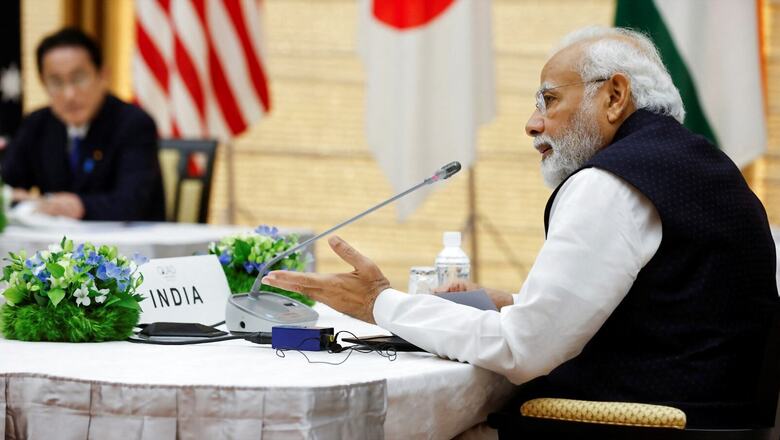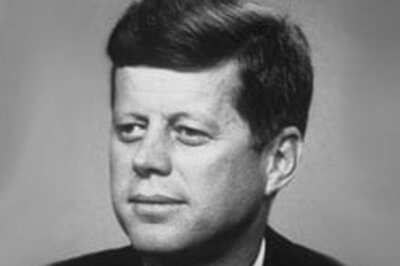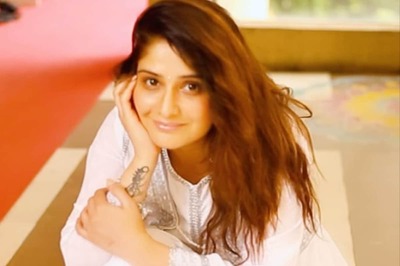
views
In foreign policy no country is a master of the international situation. Even the most powerful country in the world, like the US, has suffered many setbacks in its foreign policy all along. China, which seemed until recently to be succeeding in achieving its ambitions irresistibly, has begun to face international resistance. Russia began to credibly expand its international role as a great power in recent years, recovering some of its lost prestige, but has now suffered a severe setback to its standing as a result of the Ukraine conflict. Europe has struggled to forge a foreign policy personality of its own because of divisive pulls and pressures within the 27-member bloc, apart from the Brexit episode.
The international landscape has been changing in the last eight years. Trump’s election saw the US drawing inwards, making America First the cornerstone of his policy, withdrawing from the Paris Climate Change agreement, the nuclear deal with Iran, UNESCO, the UN Human Rights Council, and so on, delivering a blow to multilateralism no doubt, but also compelling other countries to cope with his disruptive policies. This period saw a sharp deterioration of US-China ties under Obama, and despite Trump’s efforts to reverse the course to some extent, allegations of Russian interference in the US presidential election forced Trump’s hand and the breakdown of that relationship continued, with obvious international repercussions.
China occupied, reclaimed and militarised features in the South China Sea, raising international concerns about freedom of navigation and overflight. Beijing raised political and military tensions with Japan in the East China Sea. This period saw China challenging India’s strategic interests in its neighbourhood. China developed two corridors to the Indian Ocean, one through Pakistan to the Arabian Sea and the other through Myanmar to the Bay of Bengal. The military takeover in Myanmar has caused disruptions within ASEAN and posed challenges to India. The US withdrew from Afghanistan and handed over the country to the Taliban. The emergence of Islamic State in West Asia raised the spectre of Islamic extremism spreading regionally. A dramatic change occurred in Israel’s ties with the Islamic world, especially the Gulf states. The Russia-Ukraine conflict has gravely affected Russia’s relations with the West, strengthened Russia-China ties strategically and destabilised the existing international order.
Anti-globalisation sentiment grew further in these years. The role of the WTO to ensure a rules-based global trade order was undermined. The COVID-19 pandemic unleashed a trail of death worldwide and caused immense economic dislocation. It raised issues about secure reliable supply chains, on-shoring, weaponising of critical technologies and raw materials.
All these developments have impinged on India’s foreign policy. India has had to navigate through them as best as possible, keeping in mind its national interest and recognition of its limitations. For assessing the eight years that Prime Minister Narendra Modi has been in power, the approach should not be to make a simplistic list of successes and failures in our foreign policy under his leadership but analyse the challenges India has faced in these years and how the Modi government has addressed them. The successes are not always neat and setbacks can be reversed depending on the flow of events.
ALSO SEE | Modi@8: World Leaders Raise A Toast To PM Narendra Modi’s Leadership
India and Its Neighbours
Modi has given priority to India’s relations with its neighbours. They are not easy to deal with for many reasons — a sense of insecurity towards a large neighbour, over-assertion of independence, identity issues, the use of the China card against India as a cushion against Indian hegemony, and so on. India has to constantly attend to its ties with neighbours as points of friction and misunderstanding always lurk in the shadows.
Modi has made several bilateral visits to neighbouring countries to give them a sense of importance, convey that we do not take them for granted and have a stake in their prosperity and welfare. With Nepal, there have been ups and downs in ties but India has persevered in reaching out to the Nepalese through more connectivity projects and a new emphasis on our shared cultural and religious heritage. The religious bonds between India and its neighbours have been made a instrument of our diplomacy with Sri Lanka too, which in the present state of extreme economic distress has been given generous support by India, and this despite the problematic pro-Chinese leanings of its leadership.
With Bangladesh, relations have never been as good as they are today, with economic and connectivity links being developed, the latter to ease our access to the Northeast. The Rohingya issue has been handled in a way that avoids tensions with Bangladesh as well as the issue of attacks on Hindu minorities there and the fallout of the NRC project in Assam. While President Abdulla Yameen was in power in Maldives, India faced a tough diplomatic challenge with his pro-Chinese and anti-Indian leanings but with the change in government India has retrieved its position. With Bhutan, ties remain the most cordial.
Pakistan remains a problem area for Indian diplomacy. Nawaz Sharif, ostensibly moderate, could not deliver on ties in any meaningful way despite Modi’s efforts. Imran Khan became even more toxic towards India after the abrogation of Article 370. India sent a grim warning to Pakistan with the surgical strikes and the Balakot operation that its terrorist acts against India would henceforth be severely punished. Nonetheless, in a show of pragmatism, India and Pakistan agreed on a ceasefire on the LoC, the Kartarpur corridor was opened and the meetings of the Indus Water Commission continue to be held.
It goes to the Modi governments’s credit that our position on Pakistan is better understood by our foreign partners and diplomatic pressure on us to resume dialogue with Pakistan has petered out, although the abrogation of Article 370, the suspension of internet in the Valley, the human rights situation there have evoked criticism in the West and by human rights organisations etc. But even here, the criticism has become sporadic. On the issue of terrorism itself, India has been proactive in raising it in every possible forum and obtaining preferred formulations in bilateral joint statements with many foreign partners, including the US.
In the case of Afghanistan, India’s interests have not always been taken into account in attempts to find a negotiated solution to the conflict, despite the general goodwill of the Afghan people for India. In the several formats established under the leadership of the US, Russia and China to discuss a solution, India was not always invited, even though we, along with the Central Asian states, are exposed to the fallout of any untoward developments in Afghanistan. That the US eventually handed over Afghanistan to the Taliban whom they had ousted from power post 9/11, and with solicited Pakistani cooperation, has been damaging to India’s security interests. However, India has sought to protect its equities in Afghanistan to the extent possible by providing humanitarian aid and engaging the Taliban to some extent. India has tried to secure its interests through Resolution 2593 of the UN Security Council while chairing it that calls for Afghan territory not to be used as a base for any terrorist activity against its neighbours.
India has concluded under Modi that SAARC can no longer be an effective vehicle for promoting cooperation within the subcontinent, given Pakistan’s deep-seated hostility towards India. Accordingly, the Modi government is rightly focusing on BIMSTEC as an alternative, which also fits into its Act East policy.
The Indo-Pacific and Quad
Under the Modi government, the Indian Ocean-related diplomacy of India has acquired a new vigour. New concepts to expand regional cooperation among India’s maritime neighbours have been developed, such as SAGAR under the aegis of which Modi has proposed an Indo-Pacific Oceans Initiative. The Indian Ocean Rim Association forum has been boosted, as well as an Indian Ocean Dialogue. A trilateral maritime security dialogue between India, Sri Lanka and Maldives at NSA level has been initiated with concerns about external threats including terrorism and Islamic radicalism in view.
India’s involvement and support for the Indo-Pacific concept and the Quad have grown in these eight years. The China threat and India’s readiness to assume more security responsibilities in the Indian Ocean in particular explains this, with Modi declaring for the first time that India is a net security provider in the Indian Ocean. Growing India-US defence ties, signing of logistics agreements with the US, Japan and Australia, the expansion of the Malabar exercise to include Japan and Australia, the new dynamism in India-Australia ties, all account for this. The Quad’s broader agenda, covering critical and emerging technologies, trusted supply chains, cybersecurity, connectivity, energy etc. serves India’s economic agenda, beyond the security dimension.
In these eight years, India’s relationship with the US has been consolidated as the most important as well as wide-ranging one. The US has emerged as India’s biggest trade partner despite some unresolved issues relating to market access and the withdrawal of GSP (Generalised System of Preferences) benefits to India. The data-related and social media issues will remain troublesome in ties as India must protect its interests. India under Modi has navigated successfully the Obama, Trump and now the Biden presidency, with Modi’s diplomatic success in establishing good personal rapport with personalities as far apart as Obama and Trump. The bipartisan consensus in the US Congress in favour of India has been preserved despite relentless media propaganda in the US against the Modi government on handling of some domestic Indian issues. Despite expansion of defence ties and India’s status as a Major Defence Partner, the US has not so far committed itself to supporting India meaningfully in atmanirbhata in defence manufacturing.
India has successfully resisted US and European pressure in general to take sides against Russia on the Ukraine conflict, despite several appeals to us to reduce our military ties with Russia, adhere to West’s sanctions and not purchase discounted Russian oil especially through rupee-ruble arrangements. In the UN forums, at the Tokyo Quad summit and during Modi’s recent visit to Europe, India has maintained its neutral position. In this surcharged western atmosphere on Ukraine, India’s ability to maintain a position in its national interest reflects a self-confident and persuasive Indian foreign policy. Our official statements that our western partners understand our stance on the Ukraine conflict show that it is not affecting the forward movement of our ties with the West.
An Independent Foreign Policy
The transformation of our ties with the Gulf states has been a major achievement of the Modi government, even though the foundations for this were laid earlier. Despite propaganda about BJP’s anti-minority image, Article 370, the CAA etc., India’s ties with the UAE and Saudi Arabia have acquired closeness as never before. These countries, desirous of becoming modern states, repudiating extremism and terrorism and guided by their long-term economic interests, see India as a valuable partner. The UAE invited Sushma Swaraj, then India’s foreign minister, to the OIC FMs conference hosted by it in 2019. Our military chiefs have visited these countries. Naval and air exercises have been done with the UAE. Our navy has access to the Duqm port in Oman.
India’s handling of the COVID-19 pandemic under Modi’s leadership has raised India’s image internationally. India’s willingness to supply therapeutics and India-produced vaccines despite its own needs was widely appreciated. India used its huge production capacities to diplomatic advantage, as shown also in the Quad decision to supply 1 billion doses of US-origin vaccines manufactured in India for the Indo-Pacific region with participation of Japan and Australia. That India was able to autonomously vaccinate its massive population has sent a powerful message globally about India’s credibility as a growing power. The intention behind western reports that the number of actual COVID-19 deaths in India has been grossly understated, a view supported now by WHO which the government has contested, is to cast a shadow on India’s success for political reasons.
On the issue of climate change, Modi has gained enormous credibility for India internationally by our own huge programme to build renewable energy capacity in India — 550 gigawatts by 2030. He deflected pressure on India at the Glasgow summit by announcing a cut-off date for a carbon-neutral economy by 2070. He has taken the lead internationally on the issue by launching the International Solar Alliance along with France and through his concept of a Coalition for Disaster Resilient Infrastructure, which finds mention in the Quad communiqué at Tokyo. All this without yielding on the basic issues of availability of finance and technology to assist India and the developing countries to adopt climate-friendly technologies at affordable cost. Energy transition and green hydrogen — in which India seeks leadership — are on India’s agenda under Modi.
While growing closer to the US and participating in the Quad etc., India has ensured this is not at the cost of its traditional ties with Russia. If the US assisted us in some ways to deal with China’s Ladakh aggression, so did Russia in its readiness to make available needed defence supplies. Defence ties with the US have not been at the cost of our defence and political ties with Russia. Putin was the only head of state to participate in the UN Security Council meeting under India’s presidency, which Modi chaired. India and Russia have plans to develop Russia’s Far East to access Russia’s hydrocarbon and other resources, which will now become complicated with western sanctions. India’s neutral stand on the Ukraine conflict is appreciated by Russia, which sees in it a confirmation that India is determined to pursue an independent foreign policy.
Our China policy has suffered a reverse with China’s aggression in Ladakh, the reasons for which remain unclear, other than Xi’s muscle-flexing in general. Modi had tried during these these years to build a tension-free relationship with China. He engaged Xi Jinping during personal-level summits. The first Chinese blow came at Doklam where India stood up against China’s bid to occupy strategic heights overlooking the Siliguri corridor. India has not wilted under Chinese pressure in Ladakh and has positioned 50,000 troops even during winter time to counter an equal number of Chinese troops. Military infrastructure building on our side is going apace. India has said repeatedly that India-China ties cannot be normal if the situation on the border remains abnormal. In a show of pragmatism to keep the doors of engagement open with China, border negotiations at the military and diplomatic levels have continued. This helps to prevent further incidents that could spiral out of control and also allows us to continue to engage with China in the broader RIC, BRICS and SCO forums, necessary to maintain a balance in our foreign policy as well as cover our flank with China as we deepen our involvement in the Quad and the Indo-Pacific region. India has opposed the BRI project from the start, and the formulations used by us have been adopted by the West in general. India had a role in sensitising the West on the dangers of Chinese ambitions reflected in the BRI project.
Ties with France have reached new levels of strategic trust, to the point that it has become one of our most important partners. With Israel relations continue to deepen, with a new Quad comprising of the US, India, UAE and Israel emerging to India’s west. With the EU, the FTA negotiations have been kick-started. With UK, the 2030 roadmap to enhance ties is being pursued. Germany under the new leadership is receiving attention. Not having joined the RCEP, India in a pragmatic change of policy has entered into FTAs with Australia and the UAE already, and has joined the Indo-Pacific Economic Framework launched by the US at Tokyo. With Iran, India has maintained channels of communication, with the external affairs minister visiting that country twice, as well as trade contacts without breaching the sanctions. With Turkey, relations have dipped because of its support for Pakistan on the Kashmir issue.
India’s rising stature is reflected in the second Nordic summit held by Modi, with countries that some years ago supervised us economically at the Aid India Consortium meetings. With India’s international leadership in view, Modi has had summits jointly with the Central Asian states (January 2022), with the small Pacific Island states and the Caribbean group in 2019. All ASEAN leaders jointly attended India’s R-day celebrations in 2020. Africa has been engaged during the India-Africa summit in 2015, besides some bilateral visits to key African countries when India’s African vision was spelt out in 10 pithy points to the Ugandan parliament in 2018.
A signature element of Modi’s foreign policy is his cultural diplomacy and the attention he has paid personally to the Indian diaspora everywhere, explaining his policies, inspiring them about India’s future and inculcating in them pride in their country of origin.
ALSO READ | News18 Exclusive | Modi@8: PM Modi Truly a Man With Iron Will, Writes Yogi Adityanath
Kanwal Sibal is former Indian Foreign Secretary. He was India’s Ambassador to Turkey, Egypt, France and Russia. The views expressed in this article are those of the author and do not represent the stand of this publication.
Read all the Latest Opinions here




















Comments
0 comment